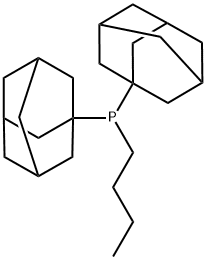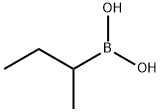Heptanoyl chloride
Synonym(s):Enanthic chloride;Oenanthic chloride
- CAS NO.:2528-61-2
- Empirical Formula: C7H13ClO
- Molecular Weight: 148.63
- MDL number: MFCD00000763
- EINECS: 219-775-3
- SAFETY DATA SHEET (SDS)
- Update Date: 2025-01-27 09:38:02

What is Heptanoyl chloride?
Chemical properties
Clear colorless to light yellow liquid
The Uses of Heptanoyl chloride
Heptanoyl Chloride is used in the synthesis of novel class of 2-Aminopyrimidines as CDK1 and CDK2 inhibitors.
The Uses of Heptanoyl chloride
Heptanoyl chloride was used in synthesis of 5α-dihydrotestosterone heptanoate and γ-ketoaldehyde. It was used in the preparation of ester-linked bilayer films.
What are the applications of Application
Heptanoyl chloride is used in the synthesis of novel class of 2-Aminopyrimidines as CDK1 and CDK2 inhibitors.
General Description
Heptanoyl chloride reacts with 2-ethylthiophene in the presence of stannic chloride to give 2-ethyl-5-heptanoylthiophene.
Hazard
Corrosive and a lachrymator.
Properties of Heptanoyl chloride
| Melting point: | -84 °C |
| Boiling point: | 173 °C (lit.) |
| Density | 0.96 g/mL at 25 °C (lit.) |
| vapor pressure | 1.18hPa at 20℃ |
| refractive index | n |
| Flash point: | 137 °F |
| storage temp. | Inert atmosphere,Room Temperature |
| solubility | soluble in Chloroform |
| form | Liquid |
| color | Clear colorless to light yellow |
| Water Solubility | REACTS |
| Sensitive | Moisture Sensitive |
| BRN | 605636 |
| Stability: | Moisture Sensitive |
| CAS DataBase Reference | 2528-61-2(CAS DataBase Reference) |
| NIST Chemistry Reference | Heptanoyl chloride(2528-61-2) |
| EPA Substance Registry System | Heptanoyl chloride (2528-61-2) |
Safety information for Heptanoyl chloride
| Signal word | Danger |
| Pictogram(s) |
 Corrosion Corrosives GHS05  Skull and Crossbones Acute Toxicity GHS06 |
| GHS Hazard Statements |
H314:Skin corrosion/irritation H330:Acute toxicity,inhalation |
| Precautionary Statement Codes |
P260:Do not breathe dust/fume/gas/mist/vapours/spray. P271:Use only outdoors or in a well-ventilated area. P280:Wear protective gloves/protective clothing/eye protection/face protection. P303+P361+P353:IF ON SKIN (or hair): Remove/Take off Immediately all contaminated clothing. Rinse SKIN with water/shower. P305+P351+P338:IF IN EYES: Rinse cautiously with water for several minutes. Remove contact lenses, if present and easy to do. Continuerinsing. |
Computed Descriptors for Heptanoyl chloride
Heptanoyl chloride manufacturer
Omicron Pharmatech Private Limited
1Y
Phone:+91-9328438466
Whatsapp: +91-9328438466
product: 2528-61-2 Heptanoyl chloride 98%
New Products
Indole Methyl Resin tert-butyl 9-methoxy-3-azaspiro[5.5]undecane-3-carboxylate Boc-His(Boc)-OH 2-CTC Resin 4-Chloro-7-tosy1-7Hpyrrolo[2,3-d]pyrimidine 5,7-Dibromo-1H-indole 2,5-dichloro-N-hydroxy-4,6-dimethylpyridine-3-carboximidamide 2,2-Dimethoxy-7-azaspiro[3.5]nonane hydrochloride 4-chloromethyl-5-methyl-1,3-dioxol-2-one (DMDO-Cl) R-2-BENZYLOXY PROPIONIC ACID 1,1’-CARBONYLDIIMIDAZOLE 1,1’-CARBONYLDI (1,2-4 TRIAZOLE) N-METHYL INDAZOLE-3-CARBOXYLIC ACID 4-((2-hydroxyethyl)thio)benzoic acid 1-(TERT-BUTOXYCARBONYL)-2-PYRROLIDINONE Methyl 6-methylnicotinate 3-Pyridineacrylic acid tert-Butyl carbazate TETRAHYDRO-2H-PYRAN-3-OL 2-((4-morpholinophenylamino) (methylthio) methylene) malononitrile 3-(4-morpholinophenylamino)-5-amino-1H-pyrazole-4-carbonitrile 2,4-dihydroxybenzaldehyde 1,3-Diethyl-1,3-Diphenylurea Methyl 2-methylquinoline-6-carboxylateRelated products of tetrahydrofuran








You may like
-
 Heptanoyl chloride 2528-61-2 98%View Details
Heptanoyl chloride 2528-61-2 98%View Details
2528-61-2 -
 Heptanoyl chloride, 99% CAS 2528-61-2View Details
Heptanoyl chloride, 99% CAS 2528-61-2View Details
2528-61-2 -
 Heptanoyl Chloride CAS 2528-61-2View Details
Heptanoyl Chloride CAS 2528-61-2View Details
2528-61-2 -
 Heptanoyl chloride CAS 2528-61-2View Details
Heptanoyl chloride CAS 2528-61-2View Details
2528-61-2 -
 Heptanoyl chloride 95.00% CAS 2528-61-2View Details
Heptanoyl chloride 95.00% CAS 2528-61-2View Details
2528-61-2 -
 Heptanoyl chloride CAS 2528-61-2View Details
Heptanoyl chloride CAS 2528-61-2View Details
2528-61-2 -
 2528-61-2 Heptanoyl chloride 98%View Details
2528-61-2 Heptanoyl chloride 98%View Details
2528-61-2 -
 Thiourea 99% ARView Details
Thiourea 99% ARView Details
62-56-6
Statement: All products displayed on this website are only used for non medical purposes such as industrial applications or scientific research, and cannot be used for clinical diagnosis or treatment of humans or animals. They are not medicinal or edible.
